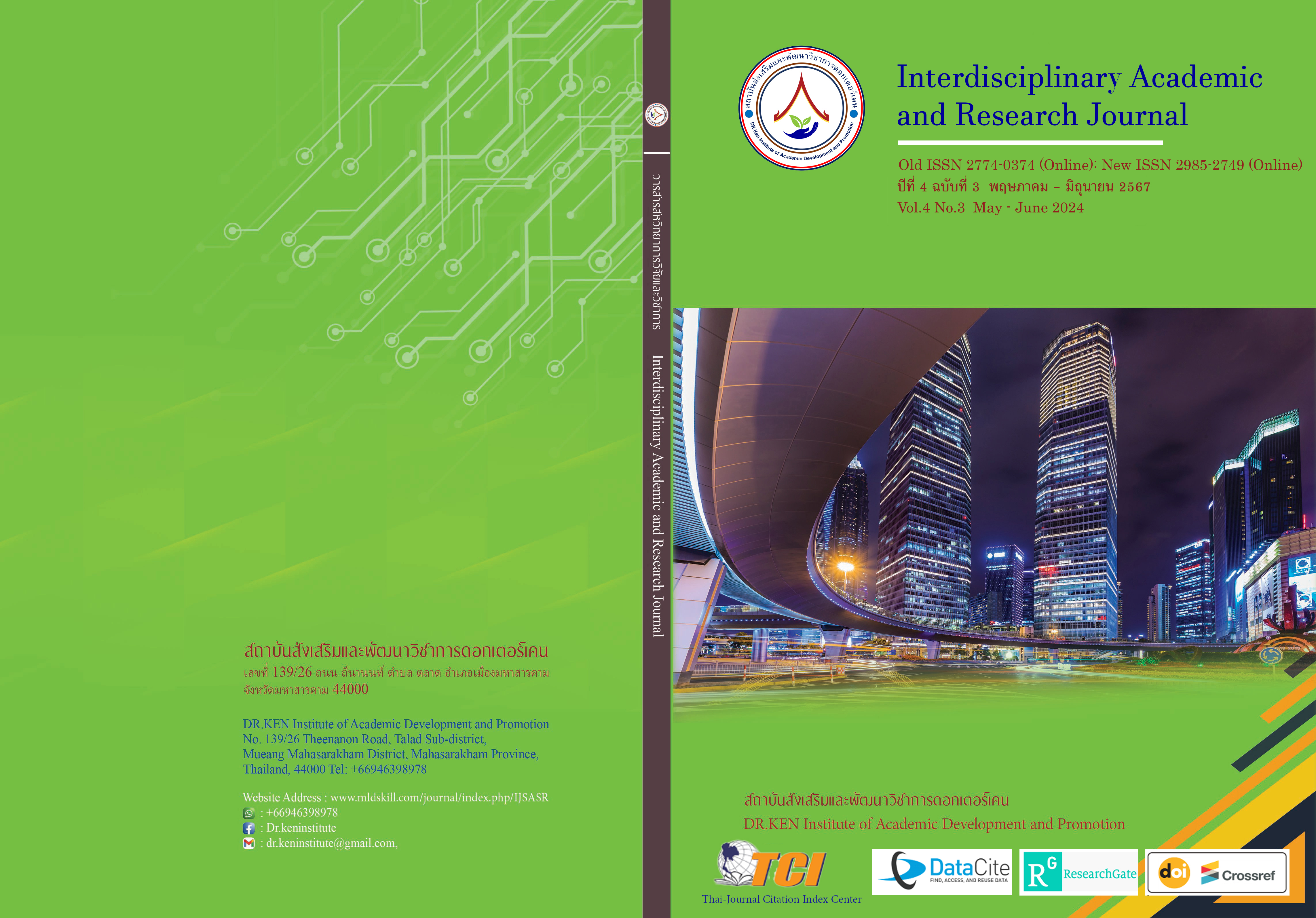The Project Evaluations of The Promoting Production Efficiency and Adding Value of Organic Vegetables in The Land Reform Area of Wang Nam Khiao District Nakhon Ratchasima Province
DOI:
https://doi.org/10.60027/iarj.2024.275252Keywords:
Project Tracking; , Production and Value Addition; , Organic Vegetables;, Wang Nam Khiao District Land Reform AreaAbstract
Background and Aims: Implementation of a series of projects to promote production efficiency and increase the value of organic vegetables in the Land Reform Area, Wang Nam Khiao District Nakhon Ratchasima Province It is part of the policy evaluation framework. Management focused on results This allows the agency to evaluate the worthiness of the project's operations, which will be beneficial to the agency. To present various projects that are continuously related to the main policy According to the steps. The purpose of this study was to assess the context, inputs, processes, and outputs of the production efficiency enhancement and value-adding project of organic vegetables in the Land Reform Area of Wang Nam Khiao District, Nakhon Ratchasima Province.
Methodology: The sample group was 1) the organizers, 2) the participants in the implementation, and 3) the stakeholders involved in the operation of the production efficiency promotion and value-added organic vegetable project series in the land reform area of Wang Nam Khiao District, Nakhon Ratchasima Province. The project was set using purposive random sampling of 40 cases, and secondary data from document data of relevant agencies. In terms of data analysis, qualitative data analysis was used.
Results: The results of the study showed that the overview of the project promotes production efficiency and increases the value of organic vegetables in the land reform area of Wang Nam Khiao District. Nakhon Ratchasima Province Therefore, it is consistent with the national policy. The project has to inquire about the needs of all relevant population groups before implementing the project in the area. The project has clear goals and project objectives. There is a meeting to explain the objectives to the working group and stakeholders before the implementation, as well as coordinate and ask for cooperation with non-toxic agricultural cooperatives in the land reform area. (Royal initiative projects), community leaders and stakeholders before implementation and allow farmers or people in the community to participate in the project implementation as a result, project goals can be put into action. The public relations ask for cooperation to cause all sectors in the community to support the project as well.
Conclusion: The study's findings highlight the importance of project overview in raising production efficiency and adding value to agricultural goods in land reform zones. Furthermore, the proactive strategy of interacting with pertinent parties, establishing precise objectives, and encouraging community involvement not only guarantees the successful execution of projects but also attracts broad support, making it easier to realize project goals and promote sustainable agricultural development.
References
กรีนเนท. (2566). ตลาดเกษตรอินทรีย์: ภาพรวม. Retrieved from: http://www.greennet.or.th.
กรีนเนท. (2566). มาตรฐานเกษตรอินทรีย์คืออะไร. Retrieved from: http://www.greennet.or.th.
คณะกรรมการพัฒนาเกษตรอินทรีย์แห่งชาติ. (2563). แผนปฏิบัติการด้านเกษตรอินทรีย์ พ.ศ. 2560-2565. สำนักงานเลขาธิการสภา ผู้แทนราษฎร, สำนักวิชาการ
นุชา สระสม. (2555). การประเมินโครงการส่งเสริมการเรียนรู้หลักสูตรเกษตรอินทรีย์ตามวิถีภูมิปัญญาไทย โรงเรียนวัดนินสุขาราม. วารสารการบริหารการศึกษา, 2(2), 334-341.
พิชญา ม่วงมณี. (2544). การประเมินโครงการเกษตรผสมผสานเพื่อการอนุรักษ์ในระยะขยายผล. เชียงใหม่: มหาวิทยาลัยเชียงใหม่
สำนักงานนโยบายและแผนทรัพยากรธรรมชาติและสิ่งแวดล้อม. (2563). รายงานตัวชี้วัด “จำนวน เกษตรกรและพื้นที่เพาะปลูกเกษตรอินทรีย์. กรุงเทพฯ : สำนักงานนโยบายและแผนทรัพยากรธรรมชาติและสิ่งแวดล้อม
สุภานี นวกุล. (2562). การประเมินผลโครงการตลาดเกษตรกรจังหวัดชัยนาท. วารสารการเมือง การบริหาร และกฎหมาย, 10(2), 259-283.
Aaker, D.A. (1991). Managing brand equity: Capitalizing on the value of a brand name. Simon and Schuster.
Brynjolfsson, E., & McAfee, A. (2014). The second Machine Age: Work, progress, and Prosperity in a time of brilliant technologies. W.W. Norton & Company.
Coelli, T.J. (1996). A guide to DEAP version 2.1: A data envelopment analysis (computer) program. CEPA Working Papers, 8.
Davenport, T.H. (1993). Process innovation: Reengineering work through information technology. Harvard Business Press.
Helfand, G.E., & Levine, E.S. (2004). Farm size and the determinants of productive efficiency in the Brazilian Center-West. Agricultural Economics, 31(2-3), 241-249.
Kagermann, H., et al. (2013). Recommendations for implementing the strategic initiative INDUSTRIE 4.0: Securing the future of German manufacturing industry. Final Report of the Industrie 4.0 Working Group. Federal Ministry of Education and Research, Berlin.
Kotler, P., & Armstrong, G. (2016). Principles of marketing. Pearson.
Lee, J., et al. (2015). Internet of things for smart manufacturing: Technologies, challenges, and opportunities. IEEE Access, 3, 2302-2319.
Liker, J.K. (2004). The Toyota Way: 14 management principles from the world's greatest manufacturer. McGraw-Hill.
Lovell, C.K. (1993). Production frontiers and productive efficiency. In H.O. Fried, C.A.K. Lovell, & S.S. Schmidt (Eds.), The measurement of productive efficiency: Techniques and applications (pp. 3-67). Oxford University Press.
Ohno, T. (1988). Toyota production system: Beyond large-scale production. Productivity Press.
Porter, M.E. (1980). Competitive strategy: Techniques for analyzing industries and competitors. Free Press.
Porter, M.E. (1985). Competitive advantage: Creating and sustaining superior performance. Free Press.
Schonberger, R.J. (2008). Best practices in lean Six Sigma process improvement. John Wiley & Sons.
Snee, R. D., & Hoerl, R. W. (2003). Leading Six Sigma: A step-by-step guide based on experience with GE and other Six Sigma companies. FT Press.
Womack, J.P., & Jones, D.T. (2003). Lean thinking: Banish waste and create wealth in your corporation. Free Press.
Womack, J.P., Jones, D.T., & Roos, D. (1990). Machine that changed the world. Simon and Schuster.
Womack, J.P., Jones, D.T., & Roos, D. (1990). The machine that changed the world: The story of lean production. Harper Perennial.
Downloads
Published
How to Cite
Issue
Section
License
Copyright (c) 2024 Interdisciplinary Academic and Research Journal

This work is licensed under a Creative Commons Attribution-NonCommercial-NoDerivatives 4.0 International License.
Copyright on any article in the Interdisciplinary Academic and Research Journal is retained by the author(s) under the under the Creative Commons Attribution-NonCommercial-NoDerivatives 4.0 International License. Permission to use text, content, images, etc. of publication. Any user to read, download, copy, distribute, print, search, or link to the full texts of articles, crawl them for indexing, pass them as data to software, or use them for any other lawful purpose. But do not use it for commercial use or with the intent to benefit any business.
















.png)


